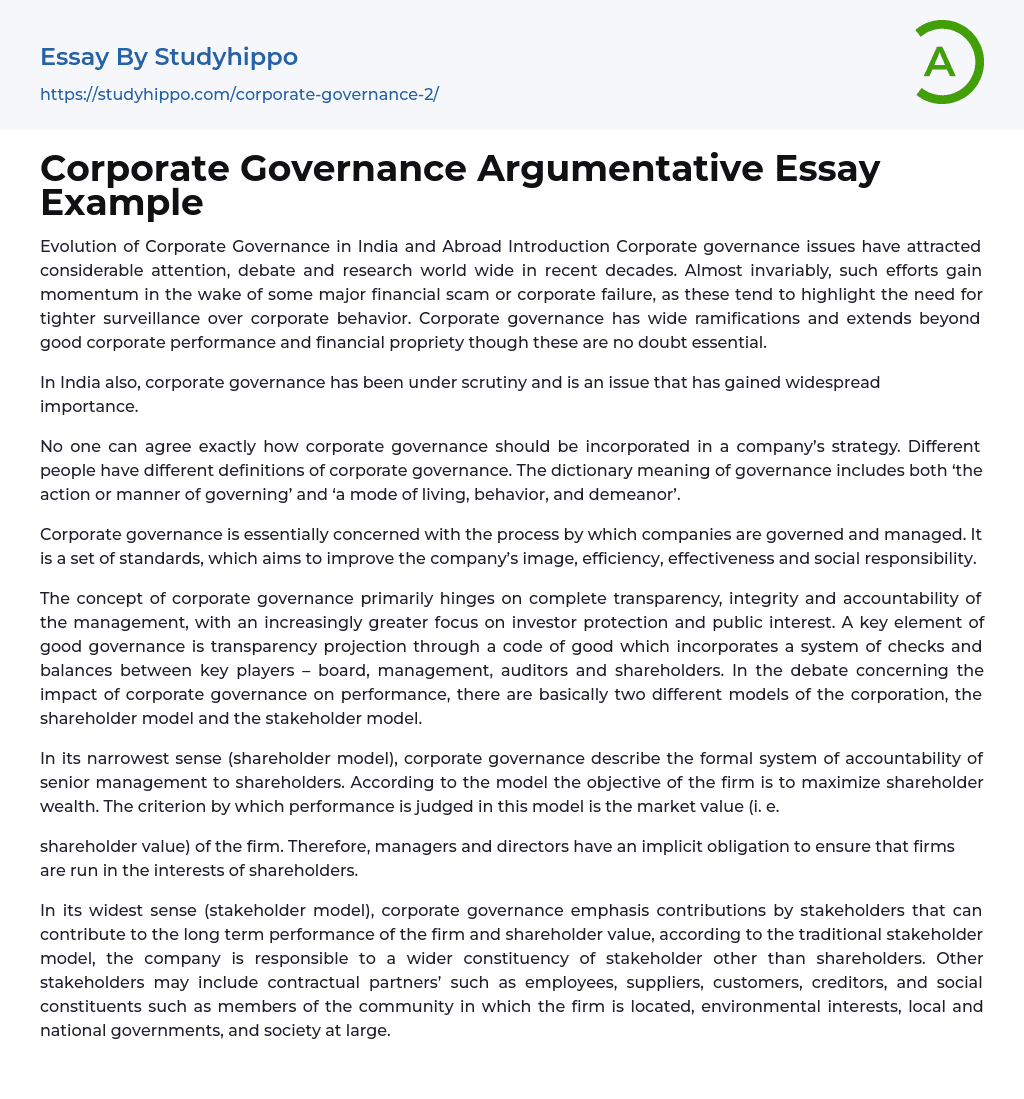Evolution of Corporate Governance in India and Abroad Introduction Corporate governance issues have attracted considerable attention, debate and research world wide in recent decades. Almost invariably, such efforts gain momentum in the wake of some major financial scam or corporate failure, as these tend to highlight the need for tighter surveillance over corporate behavior. Corporate governance has wide ramifications and extends beyond good corporate performance and financial propriety though these are no doubt essential.
In India also, corporate governance has been under scrutiny and is an issue that has gained widespread importance.
No one can agree exactly how corporate governance should be incorporated in a company’s strategy. Different people have different definitions of corporate governance. The dictionary meaning of governance includes both ‘the action or manner of governing’ and ‘a mode of living, behavior, and demeanor’.
Corporat
...e governance is essentially concerned with the process by which companies are governed and managed. It is a set of standards, which aims to improve the company’s image, efficiency, effectiveness and social responsibility.
The concept of corporate governance primarily hinges on complete transparency, integrity and accountability of the management, with an increasingly greater focus on investor protection and public interest. A key element of good governance is transparency projection through a code of good which incorporates a system of checks and balances between key players – board, management, auditors and shareholders. In the debate concerning the impact of corporate governance on performance, there are basically two different models of the corporation, the shareholder model and the stakeholder model.
In its narrowest sense (shareholder model), corporate governance describe the formal system of accountability of senior management to shareholders. Accordin
to the model the objective of the firm is to maximize shareholder wealth. The criterion by which performance is judged in this model is the market value (i. e.
shareholder value) of the firm. Therefore, managers and directors have an implicit obligation to ensure that firms are run in the interests of shareholders.
In its widest sense (stakeholder model), corporate governance emphasis contributions by stakeholders that can contribute to the long term performance of the firm and shareholder value, according to the traditional stakeholder model, the company is responsible to a wider constituency of stakeholder other than shareholders. Other stakeholders may include contractual partners’ such as employees, suppliers, customers, creditors, and social constituents such as members of the community in which the firm is located, environmental interests, local and national governments, and society at large.
This view holds that corporations should be “socially responsible” institutions, managed in the public interest.
According to this model performance is judged by a wider constituency interested in employment, market share, and growth in trading relations with suppliers and purchasers, as well as financial performance. The problem with the traditional stakeholder model of the firm is that it is difficult, if not impossible, to ensure that corporations fulfill these wider objectives. The corporate governance framework in many countries of the world, is largely inward-focused.
It, therefore, speaks mainly of the composition of management structure at various levels, the assumption being that the structure will automatically ensure quality of delivery. Further, a corporate responsibility to the external environment, its constituents, and other stakeholders has not received the attention it deserve in recommendations of many of the committees set up on corporate
governance in different parts of the world. All corporate governance systems depend on key principles: fairness and integrity, transparency and disclosures, accountability, equal treatment to all shareholders and social responsibility.
The challenges of upholding these principles depend upon the ownership structure of the corporate sector. There are two general types of corporate ownership structure: “Insider” (concentrated) and “Outsider” (dispersed). In the concentration ownership structure, ownership control is concentrated in the hands of a small number of individuals, families, holding companies, banks or other financial companies. In concentrated ownership structures, insiders exercise control over companies in several ways.
A common feature is where insiders own the majority of company’s shares and voting rights.
Most countries, especially those governed by civil laws, have concentrated ownership structure. In dispersed ownership structure, there are many owners, each of whom holds a small number of company’s shares. Small shareholders have little incentive to closely monitor company’s activities and tend not to be involved in management decisions or policies. Common law countries such as United Kingdom and United States tend to have dispersed ownership structure.
Each ownership structure has corporate governance challenges. Need and Importance
- Absolutism essays
- Appeal essays
- Bourgeoisie essays
- Contras essays
- Corporate Governance essays
- Corruption essays
- Democracy essays
- Democratic Party essays
- Developed Country essays
- Dictatorship essays
- Elections essays
- European Union essays
- Federalism essays
- Foreign essays
- Foreign policy essays
- Gentrification essays
- Hillary Clinton essays
- Income Tax essays
- International Relations essays
- John Marshall essays
- John Stuart Mill essays
- Left-Wing Politics essays
- Liberty essays
- Military essays
- Monarch essays
- Monarchy essays
- Political Corruption essays
- Political Party essays
- Political Science essays
- President Of The United States essays
- Public Service essays
- Red Cross essays
- Reform essays
- Republic essays
- Revenge essays
- Social Security essays
- Sovereign State essays
- State essays
- Supply essays
- Terrorism essays
- United Nations essays
- World Trade Organization essays
- Accounting essays
- Andrew Carnegie essays
- Automation essays
- Business Cycle essays
- Business Intelligence essays
- Business Model essays
- Business Operations essays
- Business Software essays




